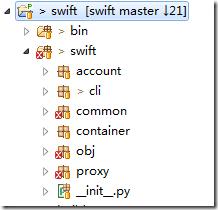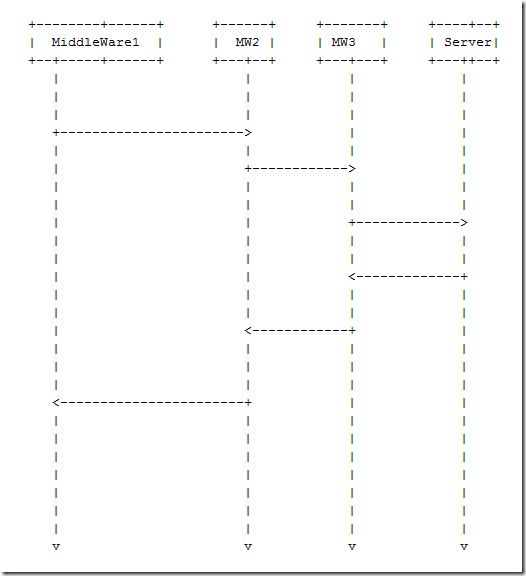OpenStack的源码分析在网上已经非常多了,针对各个部分的解读亦是非常详尽。这里我根据自己的理解把之前读过的Swift源码的一些要点记录一下,希望给需要的同学能带来一些帮助。
一、Swift的整体框架图

如上图,Swift的源码目录结构。其中proxy是前端的业务接入进程。account、container和object目录分别是账户、容器 和对象的业务处理逻辑进程。common目录是一些通用工具代码。common中比较重要的有:哈希环的处理逻辑。接下来会依次介绍各个进程的源码逻辑和 一些关键点机制。
各个业务进程或模块之间的逻辑关系可以参考《Openstack Swift简介》文中的架构图。
二、Proxy进程的业务处理
首先需要掌握基于PasteDeploy的堆栈式WSGI架构。根据PasteDeploy定义的各个层,可以很快理清配置文件定义的代码流程,从 middleware到server。找到最外层的middleware,即是业务的入口。对于proxy进程,可以简单给出业务时序图:

每一层的分工非常清晰,如在proxy进程默认配置文件中,最上层是做异常处理,所有的业务流程抛出的未处理的异常,在这里都将得到处理。
Proxy进程会分析请求的URI(account、container和object组成的资源路径)和请求方法(put、del等)来分析当前 请求的资源的具体类型,然后分贝找到控制该资源的controller,由controller来分发请求到具体的资源server。分发到原则是一致性 哈希环。一致性哈希环在系统初始化时由工具生成,在《Swift 和 Keystone单机安装总结》一文中有具体的操作步骤。
在《Openstack Swift简介》从理论上面介绍了具体的节点寻找过程。采用md5值加移位的方式来确定part,然后找到所有的虚拟节点。具体的代码为:
- container_partition, containers = self.app.container_ring.get_nodes(
- self.account_name, self.container_name)
- def get_nodes(self, account, container=None, obj=None):
- """
- Get the partition and nodes
- for an account/container/object.
- If a node is responsible
- for more than one replica, it will
- only appear in the
- output once.
- :param account: account name
- :param
- container: container name
- :param obj: object name
- :returns: a tuple of (partition, list of node dicts)
- Each node dict will have at least the following keys:
- ======
- ===============================================================
- id unique integer
- identifier amongst devices
- weight a float of the
- relative weight of this device as compared to
- others;
- this indicates how many partitions the builder will try
- to assign
- to this device
- zone integer indicating
- which zone the device is in; a given
- partition
- will not be assigned to multiple devices within the
- same zone
- ip the ip address of the
- device
- port the tcp port of the device
- device the device's name on disk (sdb1, for
- example)
- meta general use 'extra'
- field; for example: the online date, the
- hardware
- description
- ======
- ===============================================================
- """
- part = self.get_part(account,
- container, obj)
- return part,
- self._get_part_nodes(part)
- def get_part(self, account, container=None, obj=None):
- """
- Get the partition for an
- account/container/object.
- :param account: account name
- :param
- container: container name
- :param obj: object name
- :returns: the partition number
- """
- key = hash_path(account, container, obj, raw_digest=True)
- if time() >; self._rtime:
- self._reload()
- part = struct.unpack_from('>;I', key)[0] >>
- self._part_shift
- return part
- def _get_part_nodes(self, part):
- part_nodes = []
- seen_ids = set()
- for r2p2d in
- self._replica2part2dev_id:
- if
- part <; len(r2p2d):
- dev_id =
- r2p2d[part]
- if dev_id
- not in seen_ids:
- part_nodes.append(self.devs[dev_id])
- seen_ids.add(dev_id)
- return part_nodes
然后根据quorum原则来决定当前请求至少需要几个节点成功即可返回。如NWR分别为322,则至少需要2个节点写成功,才能确保此次写成功。体现在公用的make_request方法中:
- def make_requests(self, req, ring, part, method, path, headers,
- query_string=''):
- """
- Sends an
- HTTP request to multiple nodes and aggregates the results.
- It attempts the primary nodes concurrently, then iterates
- over the
- handoff nodes as needed.
- :param req: a request sent by the client
- :param ring: the ring used for finding backend servers
- :param part: the partition number
- :param method: the method to send to the backend
- :param
- path: the path to send to the backend
- (full path ends up being /<$device>/<$part>/<$path>)
- :param headers: a list of dicts, where each dict
- represents one
- backend request that should be made.
- :param query_string:
- optional query string to send to the backend
- :returns: a
- swob.Response object
- """
- start_nodes = ring.get_part_nodes(part)
- nodes =
- GreenthreadSafeIterator(self.app.iter_nodes(ring, part))
- pile = GreenAsyncPile(len(start_nodes))
- for head in
- headers:
- pile.spawn(self._make_request, nodes, part, method, path,
- head, query_string, self.app.logger.thread_locals)
- response = []
- statuses = []
- for
- resp in pile:
- if not resp:
- continue
- response.append(resp)
- statuses.append(resp[0])
- if self.have_quorum(statuses,
- len(start_nodes)):
- break
- # give any pending requests *some* chance to finish
- pile.waitall(self.app.post_quorum_timeout)
- while len(response) <; len(start_nodes):
- response.append((HTTP_SERVICE_UNAVAILABLE, '', '', ''))
- statuses, reasons, resp_headers, bodies = zip(*response)
- return self.best_response(req, statuses, reasons, bodies,
- '%s %s' % (self.server_type, req.method),
- headers=resp_headers)






























